Optimization of Ratio and Hydration Mechanism of Titanium-Extracted Residual Slag-Based Filling Cementitious Materials
Abstract
1. Introduction
2. Experimental Content
2.1. Experimental Materials
- Titanium-extracted Residual Slag
- Titanium gypsum
- Iron base total tailings
- Portland cement
- Composite activator
2.2. Mixing Experimental Design
2.3. Experimental Methodology
2.3.1. Mixing Experimental Methods
2.3.2. Methods of Micro-Mechanism Analysis
3. Response Surface Analysis of Mixing Experiment Results
3.1. Strength Regression Model Analysis for Different Maintenance Ages
- Curing compressive strength for 3d, R2 = 0.944
- Curing compressive strength for, R2 = 0.978
- Curing compressive strength for 28d, R2 = 0.977
- The cement mainly promotes the growth of 3d strength and 28d strength, and TG has a positive effect on the growth of 7d strength;
- The strength of the whole backfill mainly depends on the combination of various materials;
- The 3d strength and 28d strength of backfill are mainly affected by TRS and composite activators, and the composite activation of TRS has a significant impact on the early and late strength of backfill;
- The 7d strength of the backfill is affected by the composite effect of three kinds of materials except TRS, which will significantly reduce the 7d strength of the backfill.
3.2. Influence and Effect of Various Factors of Filling Cementing Material
3.2.1. Influence Analysis of Factors
3.2.2. Analysis of the Effects of Each Factor
3.3. The Titanium-Extracted Residual Slag-Based Filling Cementitious Materials Ratio Optimization and Evaluation
3.3.1. Ratio Optimization
3.3.2. Filling Performance Evaluation of Cementitious Materials
- Water absorption
4. Analysis of the Microscopic Hydration Mechanism of TRS Slag-Based Composite Cementitious Materials
4.1. Material Activity Mechanism Analysis
4.2. The Titanium-Extracted Residual Slag-Based Filling Cementitious Materials Hydration Mechanism Analysis
4.2.1. Hydration Products and Hydration Reactions
4.2.2. Microstructure and Strength Mechanisms
5. Conclusions
Author Contributions
Funding
Data Availability Statement
Conflicts of Interest
References
- Kesimal, A.; Yilmaz, E.; Ercikdi, B.; Alp, I.; Deveci, H. Effect of properties of tailings and binder on the short-and long-term strength and stability of cemented paste backfill. Mater. Lett. 2005, 59, 3703–3709. [Google Scholar] [CrossRef]
- Sun, K.; Fall, M. Response surface methodology-based characterization and optimization of fiber reinforced cemented tailings backfill with Slag. Int. J. Min. Reclam. Environ. 2023, 37, 735–759. [Google Scholar] [CrossRef]
- Fall, M.; Célestin, J.; Pokharel, M.; Touré, M. A contribution to understanding the effects of curing temperature on the mechanical properties of mine cemented tailings backfill. Eng. Geol. 2010, 114, 397–413. [Google Scholar] [CrossRef]
- Cao, H.; Gao, Q.; Zhang, X.; Guo, B. Research Progress and Development Direction of Filling Cementing Materials for Filling Mining in Iron Mines of China. Gels 2022, 8, 192. [Google Scholar] [CrossRef] [PubMed]
- Shao, X.; Xu, B.; Tang, R.; Liu, L.; Fang, Z.; Tian, C.; Ning, J.; Li, L. Preparation and properties of a decarbonized coal gasification slag–fly ash filling material. Environ. Sci. Pollut. Res. 2023, 30, 45015–45028. [Google Scholar] [CrossRef] [PubMed]
- Xue, G.; Yilmaz, E.; Wang, Y. Progress and prospects of mining with backfill in metal mines in China. Int. J. Miner. Metall. Mater. 2023, 30, 1455–1473. [Google Scholar] [CrossRef]
- Zhang, S.; Wu, B.; Ren, Y.; Wu, Z.; Li, Q.; Li, K.; Zhang, M.; Yu, J.; Liu, J.; Ni, W. The Preparation Process and Hydration Mechanism of Steel Slag-Based Ultra-Fine Tailing Cementitious Filler. Gels 2023, 9, 82. [Google Scholar] [CrossRef] [PubMed]
- Liu, W.; Chen, X.; Li, W.; Yu, Y.; Yan, K. Environmental assessment, management and utilization of red mud in China. J. Clean. Prod. 2014, 84, 606–610. [Google Scholar] [CrossRef]
- Ren, C.; Li, K.; Wang, Y.; Li, Y.; Tong, J.; Cai, J. Preparation and Hydration Mechanisms of Low Carbon Ferrochrome Slag-Granulated Blast Furnace Slag Composite Cementitious Materials. Materials 2023, 16, 2385. [Google Scholar] [CrossRef] [PubMed]
- Xu, Z.; Ma, Y.; Wang, J.; Shen, X. Preparation and Hydration Properties of Steel Slag-Based Composite Cementitious Materials with High Strength. Materials 2023, 16, 2764. [Google Scholar] [CrossRef] [PubMed]
- Tang, S.; Peng, T.; Sun, H.; Ding, W.; Luo, L.; You, H.; Yao, X. Influences of Friedel’s Salt Produced by CaO-Activated Titanium-Extracted Tailing Slag on Chloride Binding. Materials 2023, 16, 2843. [Google Scholar] [CrossRef] [PubMed]
- Jing, J.; Tang, S.; Peng, T.; Sun, H.; Ding, W.; Luo, L.; You, H.; Yao, X. Recent Progress in Electric Furnace Titanium Slag Processing and Utilization: A Review. Crystals 2022, 12, 958. [Google Scholar] [CrossRef]
- Li, J.; Li, A.; Hao, J.; Xu, J.; Zhang, L. Experimental study on the ratio between Ti-bearing blast furnace slag-iron-based full tailing sand and cement in cementitious filling. J. Min. Sci. Technol. 2023, 8, 838–846. (In Chinese) [Google Scholar]
- Tang, S.; Peng, T.; Sun, H.; Ding, W.; Luo, L. Influencing Mechanism of Titanium-Extracted Tailing Slag on the Strength of CaO Steel Slag Hardened Paste. Materials 2023, 16, 937. [Google Scholar] [CrossRef] [PubMed]
- Liao, G.Y. Research on Proportional Optimization and Gelation Mechanism of Yellow Phosphorus Slag Filling; Central South University: Changsha, China, 2009. [Google Scholar]
- Ren, C.; Li, K.; Ni, W.; Zhang, S. Preparation of Mine Filling Material from Steel Slag Mud. Ann. Chim. Sci. Mater. 2019, 43, 217–224. [Google Scholar] [CrossRef]
- Zhang, F.W. Investigations on Solidified Characteristics and Mechanism of Slag Cementitious Materials in Mine Filling. Ph.D. Thesis, Wuhan University, Wuhan, China, 2009. (In Chinese). [Google Scholar]
- Lan, W.T.; Wu, A.X.; Yu, P. Development of a new controlled low strength filling material from the activation of copper slag: Influencing factors and mechanism analysis. J. Clean. Prod. 2020, 246, 119060. [Google Scholar] [CrossRef]
- Zhang, J.Q.; Yang, K.; He, X.; Wei, Z.; Zhao, X.; Fang, J. Experimental Study on Strength Development and Engineering Performance of Coal-Based Solid Waste Paste Filling Material. Metals 2022, 12, 1155. [Google Scholar] [CrossRef]
- El-Didamony, H.; Hafez, A.I.; Mohammed, M.S.; Sabry, R. Prepared and properties of filled and pozzolanic-filled cement from marble dust waste and granulated slag. J. Therm. Anal. Calorim. 2020, 139, 839–847. [Google Scholar] [CrossRef]
- The General Administration of Quality Supervision, Inspection and Quarantine of the People’s Republic of China, the Standardization Administration of China. GB/T 18046-2017; Ground Granulated Blast Furnace Slag Used for Cement, Mortar and Concrete. China Building Materials Federation: Beijing, China, 2018.
- GB/T51450-2022; Metal and Non-Metal Mine Filling Engineering Technical Standard. Ministry of Housing and Urban-Rural Development: Beijing, China, 2022.
- De Carvalho, J.M.F.; Defaveri, K.; Mendes, J.C.; Schmidt, W.; Kuehne, H.C.; Peixoto, R.A.F. Influence of particle size-designed recycled mineral admixtures on the properties of cement-based composites. Constr. Build. Mater. 2021, 272, 121640. [Google Scholar] [CrossRef]
- Sanderson, R.A.; Cann, G.M.; Provis, J.L.; Ukpata, J.O.; Basheer, P.A.M.; Black, L.; Wang, P.Z.; Trettin, R.; Rudert, V.; Adam, T. The effect of blast-furnace slag particle size on the hydration of slag–Portland cement grouts at elevated temperatures. Adv. Cem. Res. 2018, 30, 337–344. [Google Scholar] [CrossRef]
- Murgier, S.; Zanni, H.; Gouvenot, D. Blast furnace slag cement: A 29Si and 27Al NMR study. Comptes Rendus Chim. 2004, 7, 389–394. [Google Scholar] [CrossRef]
- Li, Y.; Liu, X.; Sun, H.; Cang, D. Mechanism of phase separation in BFS (blast furnace slag) glass phase. Sci. China Technol. Sci. 2011, 54, 105–109. [Google Scholar] [CrossRef]
- Ganesh Babu, K.; Kumar, V.S.R. Efficiency of GGBS in concrete. Cem. Concr. Res. 2000, 30, 1031–1036. [Google Scholar] [CrossRef]
- Yong-ping, A.I.; Xie, S.-K. Hydration Mechanism of Gypsum–Slag Gel Materials. J. Mater. Civ. Eng. 2020, 32, 04019326. [Google Scholar] [CrossRef]
- Tang, C.; Mu, X.; Ni, W.; Xu, D.; Li, K. Study on Effects of Refining Slag on Properties and Hydration of Cemented Solid Waste-Based Backfill. Materials 2022, 15, 8338. [Google Scholar] [CrossRef] [PubMed]
- Liu, Z.; Ni, W.; Li, Y.; Ba, H.; Li, N.; Ju, Y.; Zhao, B.; Jia, G.; Hu, W. The mechanism of hydration reaction of granulated blast furnace slag-steel slag-refining slag-desulfurization gypsum-based clinker-free cementitious materials. J. Build. Eng. 2021, 44, 103289. [Google Scholar] [CrossRef]
- Dong, Y.; Feng, C.; Zhao, Q.; Liang, X. Study on the Structure of C-S-H Gels of Slag–Cement Hardened Paste by 29Si, 27Al MAS NMR. Appl. Magn. Reson. 2019, 50, 1345–1357. [Google Scholar] [CrossRef]
- Wang, Z.; Wang, Z.; Xia, H.; Wang, H. Analysis of hydration mechanism and microstructure of composite cementitious materials for filling mining. J. Wuhan Univ. Technol. Mater. Sci. Ed. 2017, 32, 910–913. [Google Scholar] [CrossRef]
- Zhao, X.; Yang, K.; He, X.; Wei, Z.; Zhang, J. Study on proportioning experiment and performance of solid waste for underground backfilling. Mater. Today Commun. 2022, 32, 103863. [Google Scholar] [CrossRef]
- Xu, W.; Tian, M.; Li, Q. Time-dependent rheological properties and mechanical performance of fresh cemented tailings backfill containing flocculants. Miner. Eng. 2020, 145, 106064. [Google Scholar] [CrossRef]
- Zhu, M.; Xie, G.; Liu, L.; Wang, R.; Ruan, S.; Yang, P.; Fang, Z. Strengthening mechanism of granulated blast-furnace slag on the uniaxial compressive strength of modified magnesium slag-based cemented backfilling material. Process Saf. Environ. Prot. 2023, 174, 722–733. [Google Scholar] [CrossRef]

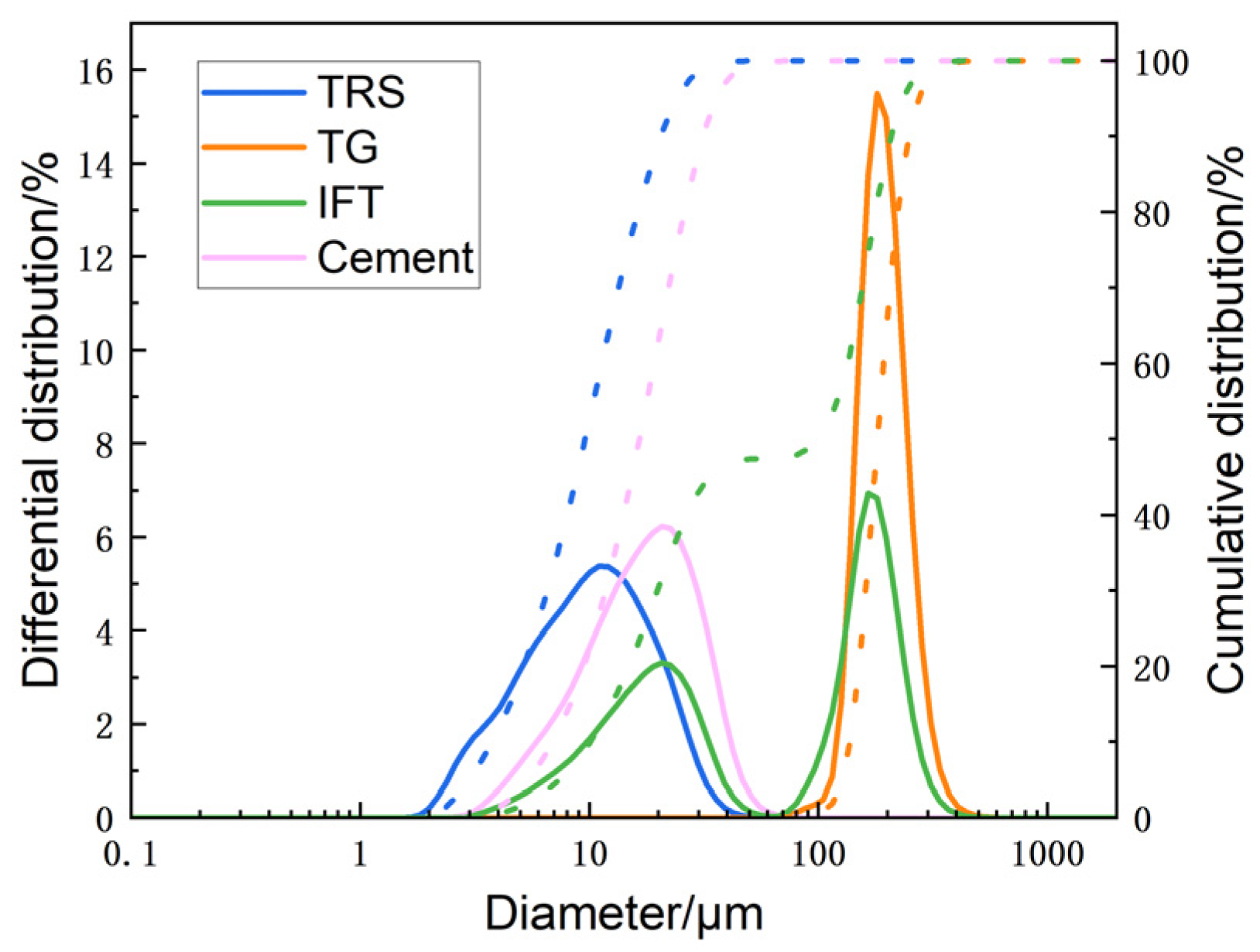
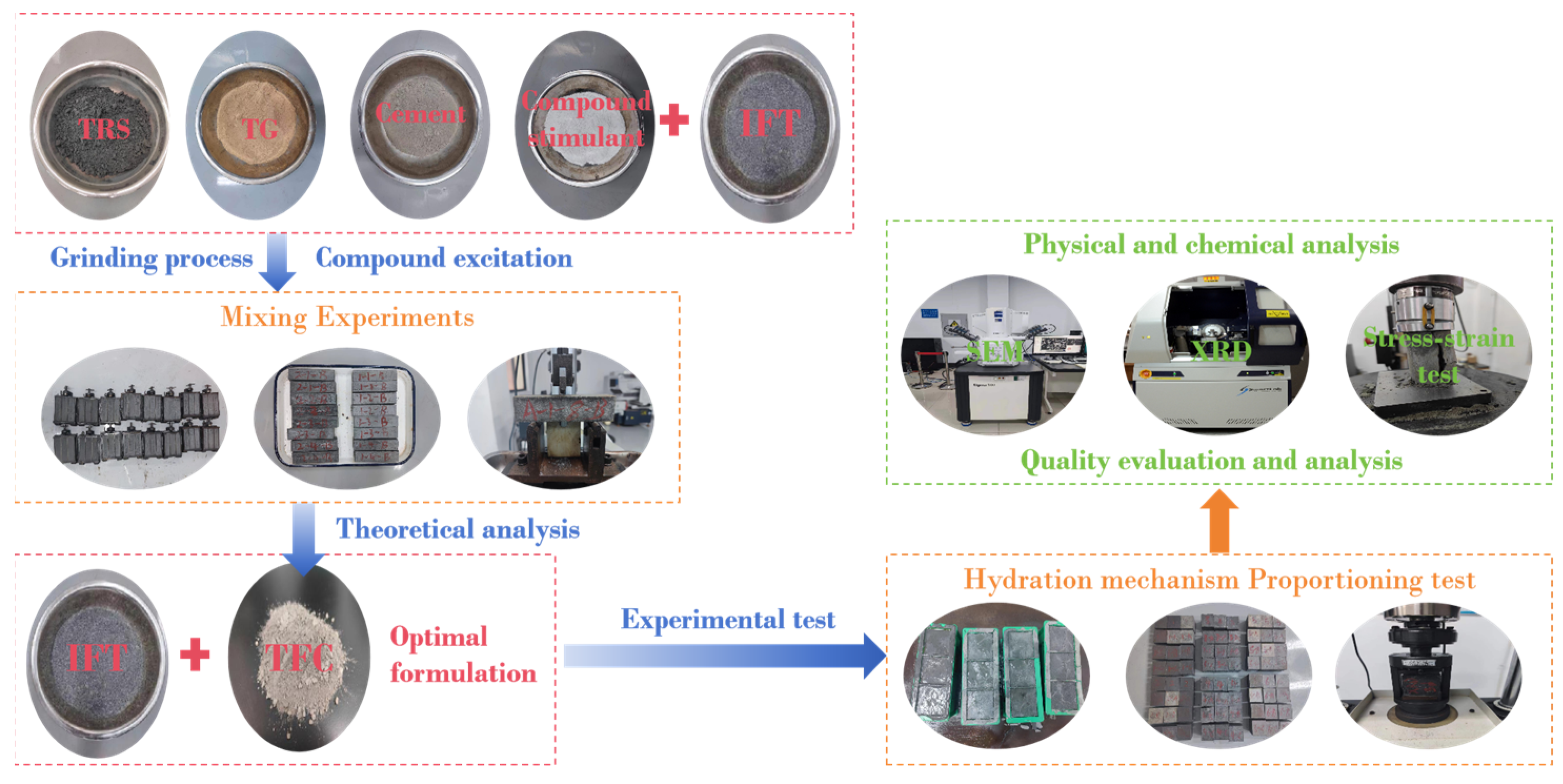
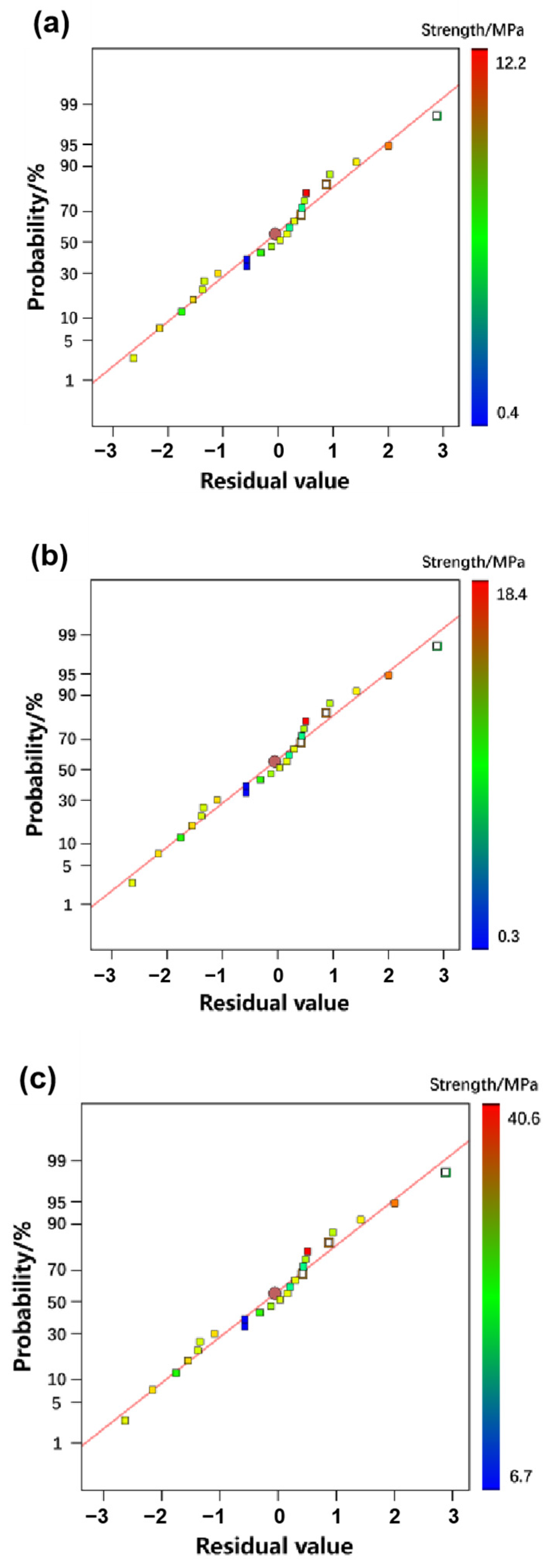


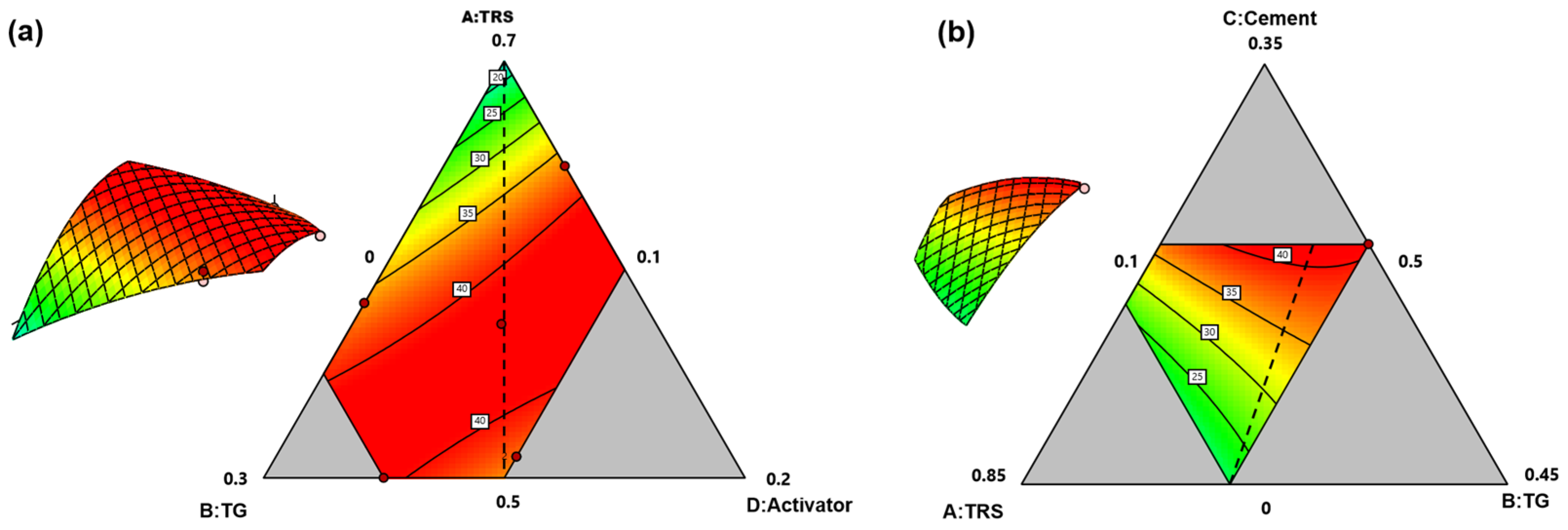
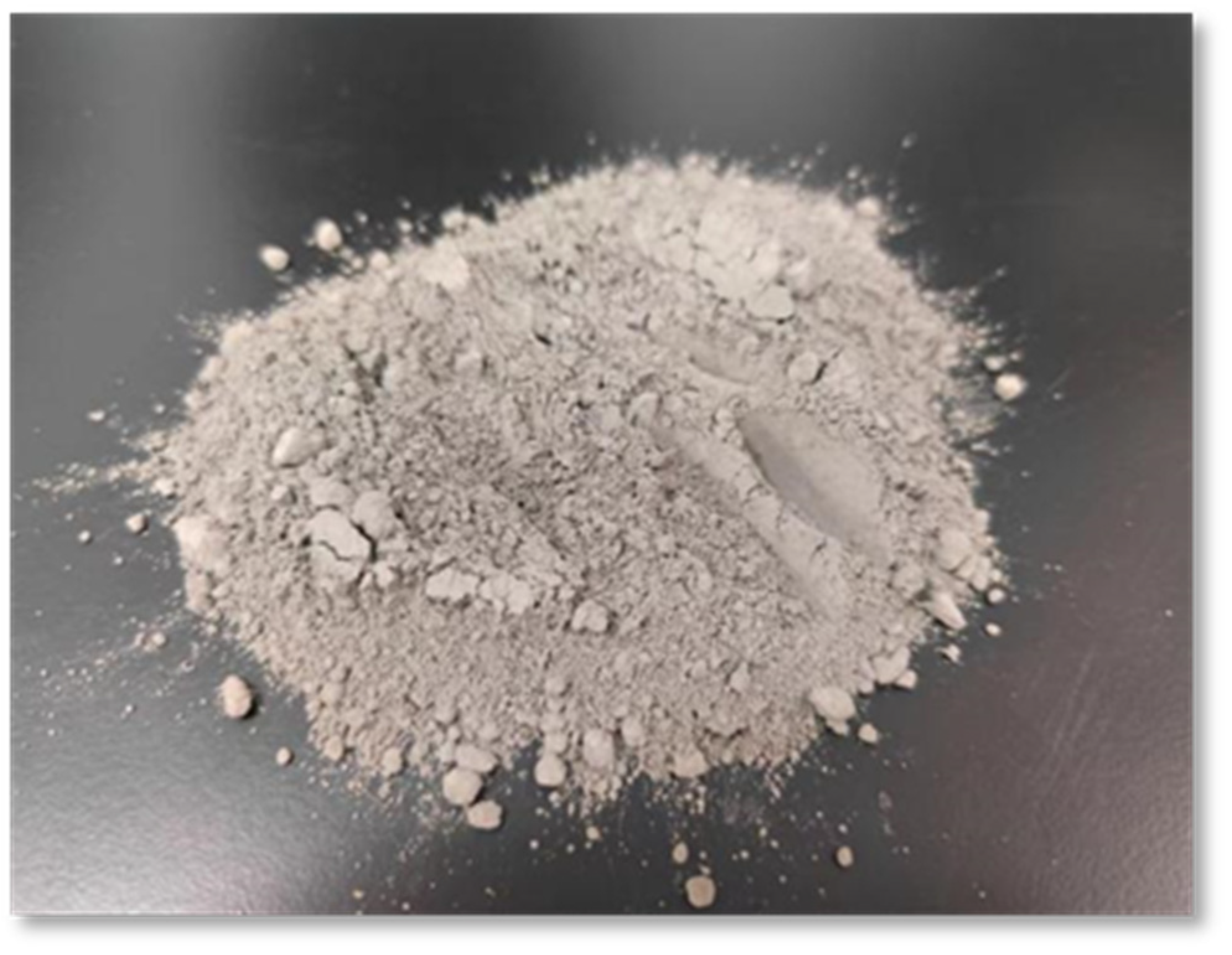
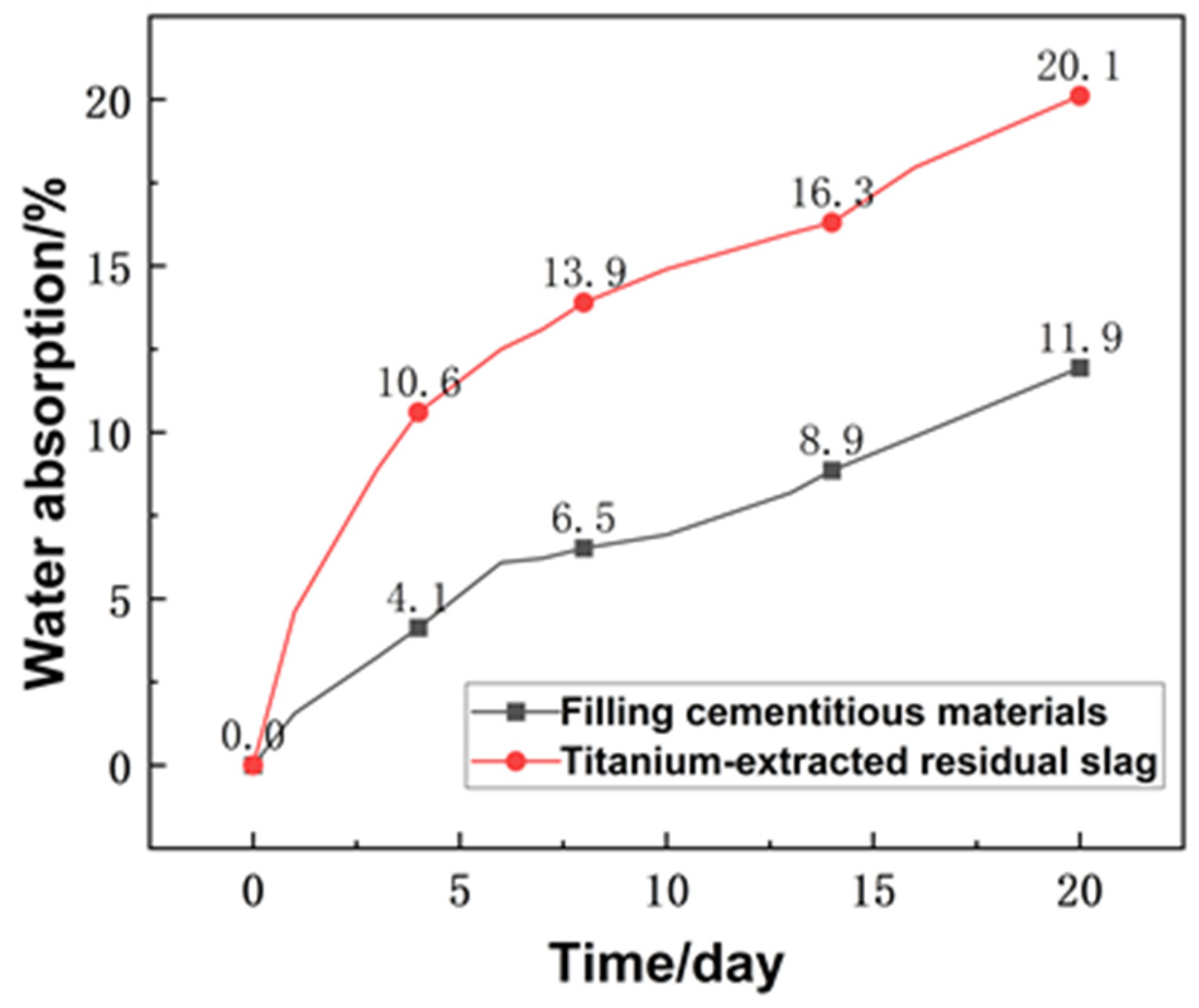
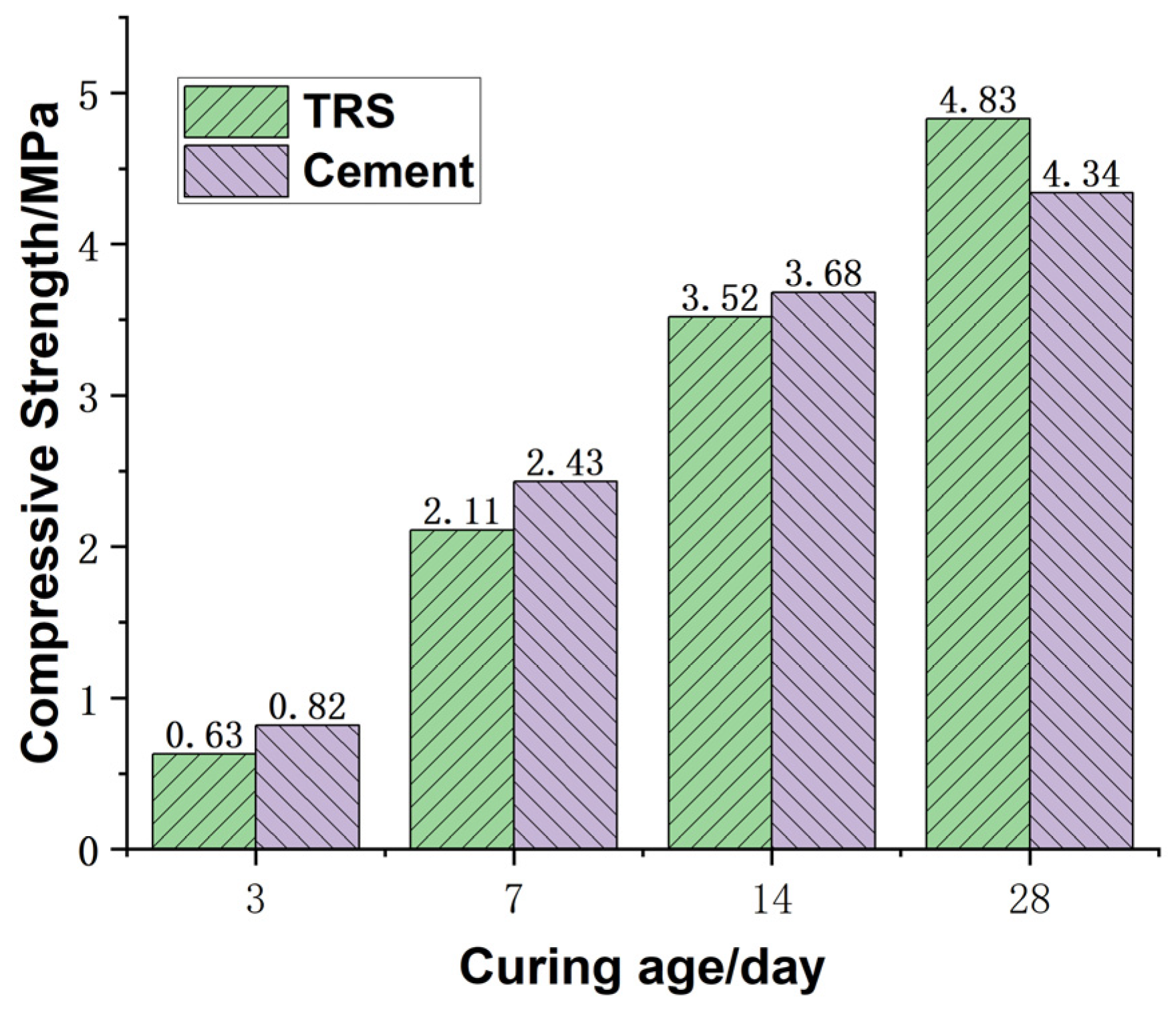


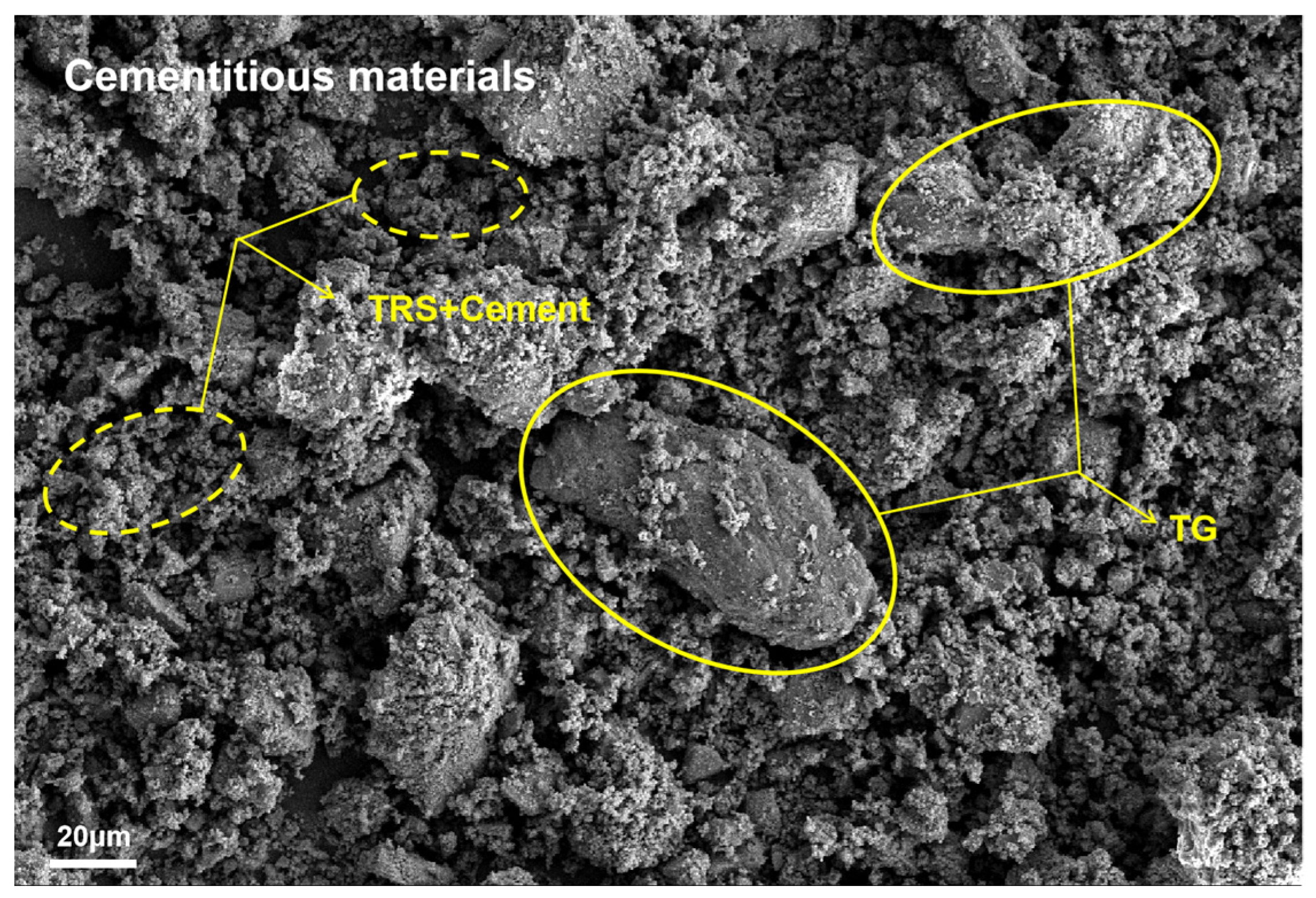
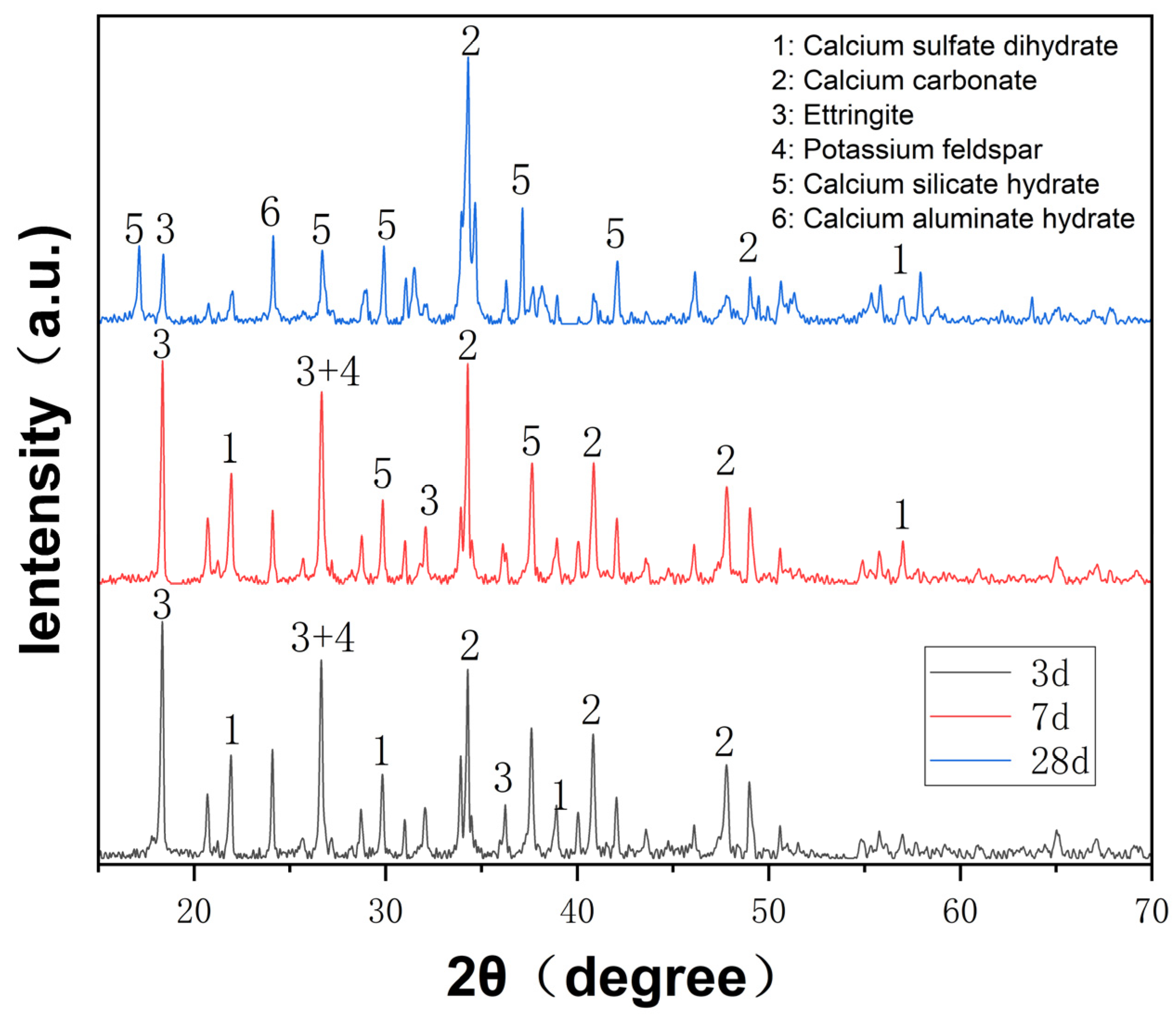
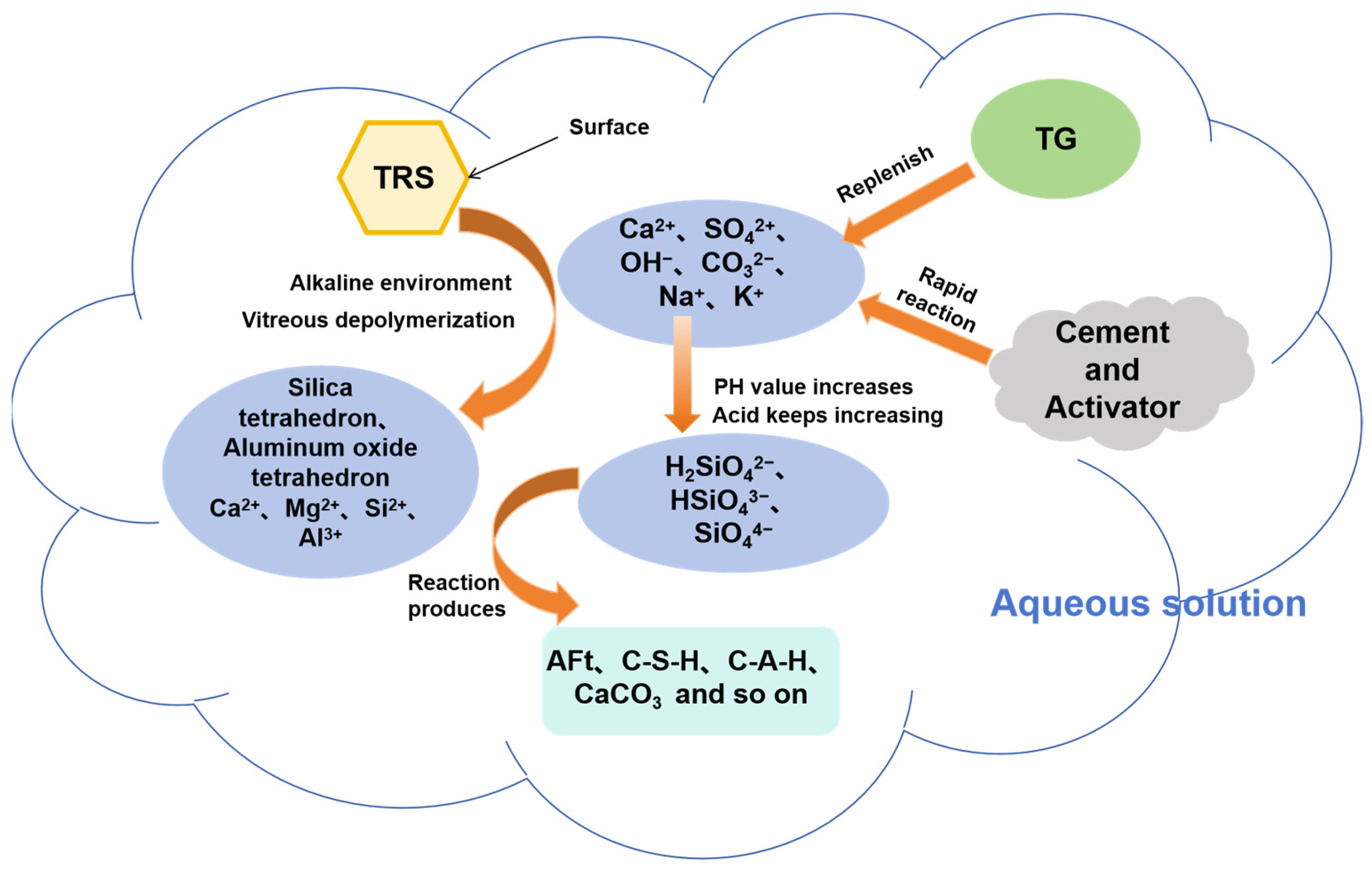
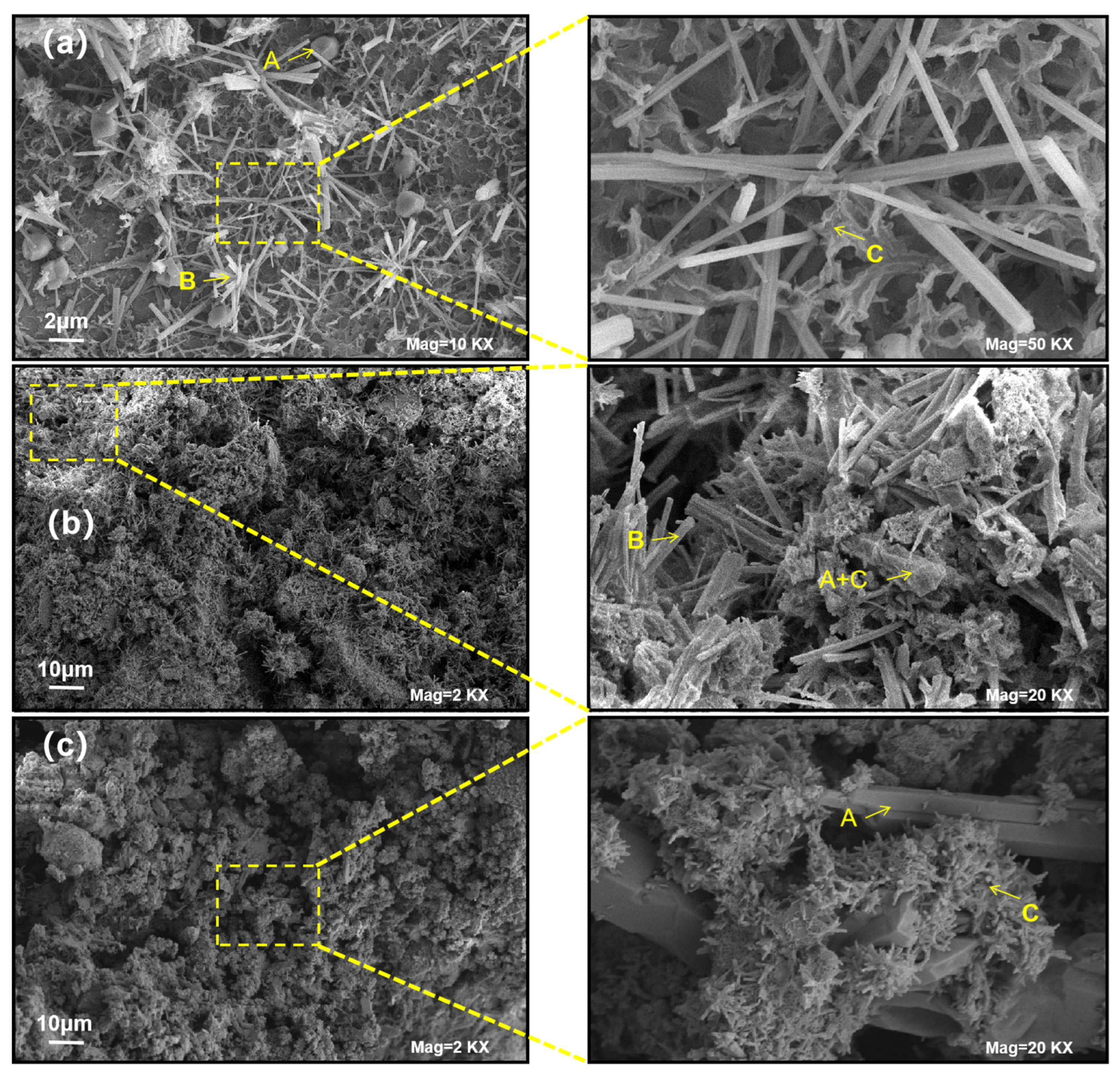
| ω% | CaO | MgO | MnO | SiO2 | TiO2 | Al2O3 | SO3 | Fe2O3 | Cl | TiC | Na2O | V2O5 |
|---|---|---|---|---|---|---|---|---|---|---|---|---|
| TBS | 26.52 | 8.78 | 0.71 | 25.3 | 5.98 | 13.15 | 0.98 | — | 3.28 | 2.75 | — | — |
| IFT | 12.7 | 9.2 | 0.181 | 37.49 | 4.355 | 13.2 | 1.01 | 13.24 | 0.026 | — | 0.98 | — |
| TG | 30.66 | 5.21 | 0.179 | 1.83 | 1.44 | 0.68 | 36.53 | 17.78 | — | — | — | 0.033 |
| Number | Component Proportion/% | Compressive Strength/MPa | |||||
|---|---|---|---|---|---|---|---|
| A | B | C | D | 3d | 7d | 28d | |
| 1 | 0.70 | 0.13 | 0.17 | 0.00 | 5.1 | 6.98 | 14.07 |
| 2 | 0.70 | 0.17 | 0.09 | 0.05 | 8.33 | 9.85 | 18.70 |
| 3 | 0.70 | 0.25 | 0.00 | 0.05 | 5.43 | 7.80 | 24.30 |
| 4 | 0.51 | 0.25 | 0.14 | 0.10 | 8.68 | 10.10 | 32.00 |
| 5 | 0.62 | 0.20 | 0.12 | 0.06 | 9.87 | 14.48 | 33.63 |
| 6 | 0.64 | 0.21 | 0.05 | 0.10 | 9.20 | 12.10 | 36.50 |
| 7 | 0.70 | 0.13 | 0.17 | 0.00 | 5.47 | 6.85 | 13.93 |
| 8 | 0.68 | 0.25 | 0.07 | 0.00 | 0.33 | 0.53 | 6.70 |
| 9 | 0.57 | 0.16 | 0.20 | 0.06 | 11.13 | 14.10 | 40.57 |
| 10 | 0.50 | 0.25 | 0.20 | 0.05 | 11.27 | 13.08 | 39.70 |
| 11 | 0.58 | 0.22 | 0.20 | 0.00 | 10.50 | 16.25 | 36.60 |
| 12 | 0.68 | 0.10 | 0.12 | 0.10 | 10.57 | 12.38 | 39.40 |
| 13 | 0.65 | 0.18 | 0.12 | 0.05 | 12.20 | 15.35 | 33.77 |
| 14 | 0.58 | 0.22 | 0.20 | 0.00 | 8.67 | 14.55 | 35.53 |
| 15 | 0.68 | 0.10 | 0.12 | 0.10 | 10.07 | 12.63 | 38.70 |
| 16 | 0.68 | 0.25 | 0.07 | 0.00 | 0.30 | 0.40 | 8.90 |
| 17 | 0.56 | 0.25 | 0.15 | 0.04 | 10.17 | 18.35 | 37.87 |
| 18 | 0.51 | 0.19 | 0.20 | 0.10 | 10.43 | 13.38 | 39.37 |
| 19 | 0.51 | 0.19 | 0.20 | 0.10 | 10.17 | 13.23 | 36.23 |
| 20 | 0.62 | 0.20 | 0.12 | 0.06 | 11.03 | 15.70 | 35.63 |
| 21 | 0.70 | 0.20 | 0.00 | 0.10 | 9.30 | 14.50 | 34.77 |
| 22 | 0.57 | 0.25 | 0.08 | 0.10 | 8.77 | 13.40 | 38.17 |
| 23 | 0.65 | 0.10 | 0.20 | 0.05 | 8.60 | 13.40 | 34.37 |
| 24 | 0.62 | 0.13 | 0.15 | 0.10 | 9.07 | 13.08 | 39.80 |
| Source | Sum of Squares | df | Mean Square | F-Value | p-Value | ||||||||
|---|---|---|---|---|---|---|---|---|---|---|---|---|---|
| S1 | S2 | S3 | S1 | S2 | S3 | S1 | S2 | S3 | S1 | S2 | S3 | ||
| Model | 209.23 | 461.19 | 2534.66 | 13 | 16.09 | 35.47 | 194.97 | 19.28 | 64.17 | 42.75 | <0.0001 | <0.0001 | <0.0001 |
| Line mixture | 116.11 | 174.44 | 1671.91 | 3 | 38.70 | 58.14 | 557.30 | 46.38 | 105.18 | 122.20 | <0.0001 | <0.0001 | <0.0001 |
| AB | 2.04 | 2.00 | 4.71 | 1 | 2.04 | 2.00 | 4.71 | 2.45 | 3.63 | 1.03 | 0.148 | 0.085 | 0.333 |
| AC | 6.50 | 33.40 | 20.64 | 1 | 6.50 | 33.40 | 20.64 | 7.79 | 60.41 | 4.52 | 0.019 | <0.0001 | 0.059 |
| AD | 2.28 | 14.96 | 10.14 | 1 | 2.28 | 14.96 | 10.14 | 2.73 | 27.06 | 2.22 | 0.129 | 0.0003 | 0.166 |
| BC | 5.14 | 17.91 | 7.10 | 1 | 5.14 | 17.91 | 7.10 | 6.16 | 32.41 | 1.55 | 0.032 | 0.0002 | 0.240 |
| BD | 3.66 | 9.16 | 5.60 | 1 | 3.66 | 9.16 | 5.60 | 4.39 | 16.57 | 1.22 | 0.062 | 0.002 | 0.293 |
| CD | 4.23 | 29.36 | 9.14 | 1 | 4.23 | 29.36 | 9.14 | 5.08 | 53.12 | 2.00 | 0.047 | <0.0001 | 0.187 |
| ABC | 2.10 | 4.07 | 1.66 | 1 | 2.10 | 4.07 | 1.66 | 2.52 | 7.36 | 0.36 | 0.143 | 0.021 | 0.558 |
| ABD | 1.10 | 1.21 | 4.45 | 1 | 1.10 | 1.21 | 4.45 | 1.32 | 2.19 | 0.97 | 0.276 | 0.169 | 0.346 |
| ACD | 2.57 | 29.39 | 8.52 | 1 | 2.57 | 29.39 | 8.52 | 3.09 | 53.16 | 1.86 | 0.109 | <0.0001 | 0.201 |
| BCD | 2.82 | 19.20 | 8.78 | 1 | 2.82 | 19.20 | 8.78 | 3.38 | 34.73 | 1.92 | 0.095 | 0.0001 | 0.195 |
| Residual | 8.34 | 5.52 | 45.60 | 10 | 0.83 | 0.55 | 4.56 | ||||||
| Lack of Fit | 6.25 | 3.28 | 33.64 | 4 | 1.56 | 0.822 | 8.41 | 4.48 | 2.19 | 4.22 | 0.0511 | 0.186 | 0.057 |
| Pure Error | 2.09 | 2.24 | 11.95 | 6 | 0.34 | 0.37 | 1.99 | 64.17 | 42.75 | ||||
| Cor Total | 217.58 | 466.72 | 2580.26 | 23 | |||||||||
| Order | Optimized Combination/% | Predicted/MPa | Actual/MPa | Predicted Deviations/% | |||||||||
|---|---|---|---|---|---|---|---|---|---|---|---|---|---|
| A | B | C | D | 3d | 7d | 28d | 3d | 7d | 28d | 3d | 7d | 28d | |
| 1 | 0.55 | 0.25 | 0.17 | 0.03 | 10.24 | 18.35 | 44.22 | 10.73 | 17.92 | 41.20 | 4.79 | 2.34 | 6.83 |
| 2 | 0.65 | 0.25 | 0 | 0.1 | 8.55 | 10.34 | 39.45 | 9.25 | 11.34 | 38.63 | 8.19 | 9.67 | 2.08 |
| 3 | 0.57 | 0.25 | 0.12 | 0 | 10.32 | 14.83 | 40.03 | 10.23 | 14.27 | 38.80 | 0.87 | 3.78 | 3.07 |
Disclaimer/Publisher’s Note: The statements, opinions and data contained in all publications are solely those of the individual author(s) and contributor(s) and not of MDPI and/or the editor(s). MDPI and/or the editor(s) disclaim responsibility for any injury to people or property resulting from any ideas, methods, instructions or products referred to in the content. |
© 2024 by the authors. Licensee MDPI, Basel, Switzerland. This article is an open access article distributed under the terms and conditions of the Creative Commons Attribution (CC BY) license (https://creativecommons.org/licenses/by/4.0/).
Share and Cite
Li, J.; Li, A.; Hao, J.; Xu, J.; Li, M.; Zhou, K. Optimization of Ratio and Hydration Mechanism of Titanium-Extracted Residual Slag-Based Filling Cementitious Materials. Minerals 2024, 14, 416. https://doi.org/10.3390/min14040416
Li J, Li A, Hao J, Xu J, Li M, Zhou K. Optimization of Ratio and Hydration Mechanism of Titanium-Extracted Residual Slag-Based Filling Cementitious Materials. Minerals. 2024; 14(4):416. https://doi.org/10.3390/min14040416
Chicago/Turabian StyleLi, Jielin, Ao Li, Jianzhang Hao, Jiye Xu, Ming Li, and Keping Zhou. 2024. "Optimization of Ratio and Hydration Mechanism of Titanium-Extracted Residual Slag-Based Filling Cementitious Materials" Minerals 14, no. 4: 416. https://doi.org/10.3390/min14040416
APA StyleLi, J., Li, A., Hao, J., Xu, J., Li, M., & Zhou, K. (2024). Optimization of Ratio and Hydration Mechanism of Titanium-Extracted Residual Slag-Based Filling Cementitious Materials. Minerals, 14(4), 416. https://doi.org/10.3390/min14040416







